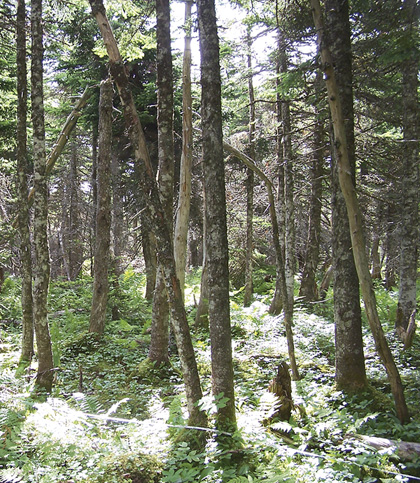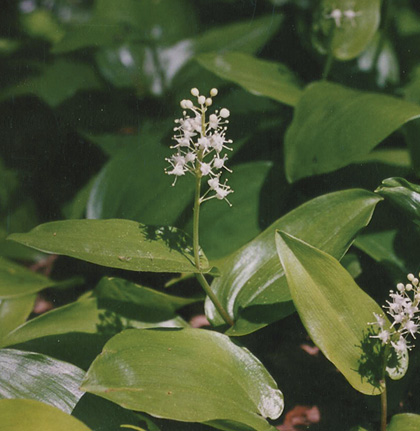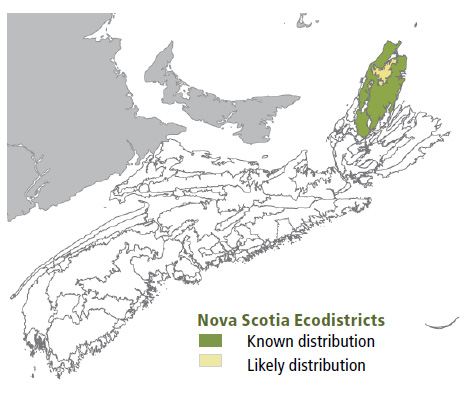
Forest Vegetation types - HL1
HL1 — Balsam fir / Mountain-ash / Large-leaved goldenrod
Abies balsamea / Sorbus americana / Solidago macrophylla
HL1a —White birch / Wood sorrel variant
Betula papyrifera / Oxalis acetosella
 |
Cheticamp Plateau, CBHNP, Inverness County |
Concept: This late successional Vegetation Type (VT) has abundant balsam fir with scattered white spruce and birch. The HL1a variant describes stands where white and/or heart-leaf birch co-dominate with balsam fir, in a mixedwood condition. HL1 has stronger boreal affinity than any other mesic VT in Nova Scotia. Balsam fir / Mountain-ash / Large-leaved goldenrod is restricted to elevations over 300 meters and is the dominant VT found in the Cape Breton Highlands.
Vegetation: Balsam fir is the dominant overstory tree. Common canopy associates include white spruce, white birch, heart-leaf birch and/or, less often, yellow birch. In variant HL1a, white and/or heart-leaf birch is co-dominant with balsam fir; here, scattered maple (red, sugar, striped) can also occur. The poorly developed shrub layer consists mainly of regenerating balsam fir with lesser mountain-ash. In contrast, the herb layer is often well developed, including bunchberry, wood aster, wild lily-of-the-valley, goldthread, wood sorrel, sarsaparilla, bluebead lily and scattered ferns. These same understory species occur in variant HL1a, accompanied by more extensive fern cover (especially wood ferns) and increased sedge presence. Large-leaved goldenrod is characteristic of this VT; it is typically scattered throughout most stands. The bryophyte layer is usually well developed. Schreber's moss is the main species along with broom moss and bazzania. Stair-step moss and sphagnum species may also be found in wetter microsites.
Environmental Setting: HL1 is mainly associated with fresh to moist, nutrient medium soils derived from glacial till. This VT is found over most of the rolling topography of the Cape Breton Highland plateau. Wind and exposure significantly limit tree growth. This ecosystem is common in northern New Brunswick and Quebec's southern boreal forest.
Successional Dynamics: HL1 is an even-aged, late successional VT usually dominated by balsam fir. The main stand-level disturbance agents are spruce budworm defoliation and harvesting. In the absence of defoliation or harvesting events, the lifespan of balsam fir in this ecosystem approaches about 75 years, after which tree senescence initiates renewal through advanced regeneration. Clearcut harvesting or, less commonly, fire may initiate an earlier successional stage dominated by pin cherry, white and/or heart-leaf birch, raspberry, mountain-ash and other woody shrubs. Heavy browsing by the moose population is also shaping balsam fir successional patterns, particularly in young post-budworm stands. In most of these, young balsam fir and hardwood saplings have been stripped out, leaving an open grassland of bluejoint and stunted regeneration and limiting HL1 development in the Cape Breton Highlands.
Ecological Features: This matrix community is primarily associated with the Maritime Boreal Cape Breton plateau. The forest's longevity is a function of either natural tree senescence (approximately 75-100 years) or the frequency of spruce budworm epidemics, creating a landscape matrix dominated by a single development stage. Fauna and ground vegetation are characterized by reduced species richness. Subnivean habitat (the space under the snow) is especially critical for the many small mammals, and their predators, found in this forest. The forest floor structure is enhanced by abundant coarse woody debris, raised stumps, and the deep moss characteristic of this VT. These forest conditions are home to snowshoe hare, moose, spruce grouse, boreal chickadee, raven and black-backed woodpecker. Small populations of American marten, Canada lynx and Bicknell's thrush (all listed as species at risk) are restricted largely to these highlands. Mountain-ash, an important component of highland forests, often reaches tree size, and provides abundant fruit and browse.
 |
| Wild lily-of-the-valley |
Distinguishing Features: This balsam fir dominated softwood forest is described for the Cape Breton Highland plateau. The variant, HL1a, has a significant component of white and/or heart-leaf birch. Large-leaved goldenrod and mountain-ash are usually present.
| Slope Position: | Level3 Middle3 Upper3 Lower1 |
Surface Stoniness: |
(Non - Slightly)8 (Moderately)2 |
Bedrock Outcrop: |
(Non-rocky)10 |
Elevation Range: |
139 - 473m |
Slope Gradient: |
Gentle5 Level2 Moderate2 Steep1 |
Aspect: |
East2 South3 West4 None1 |
Exposure: |
Exposed8 Mod. exposed2 |
Microtopography: |
Moderately6 Slightly2 Level1 Strongly1 |
Drainage: |
Moderately well4 Imperfect3 Well3 |
Soil Type: |
ST2-L3 ST33 ST22ST3-L2 |
Parent Material: |
Glacial till10 |
Rooting Depth (cm): |
(<30)4 (30-45)5 (>45)1 |
Duff Thickness (cm): |
(0-5)1 (6-10)5 (11-20)4 |

